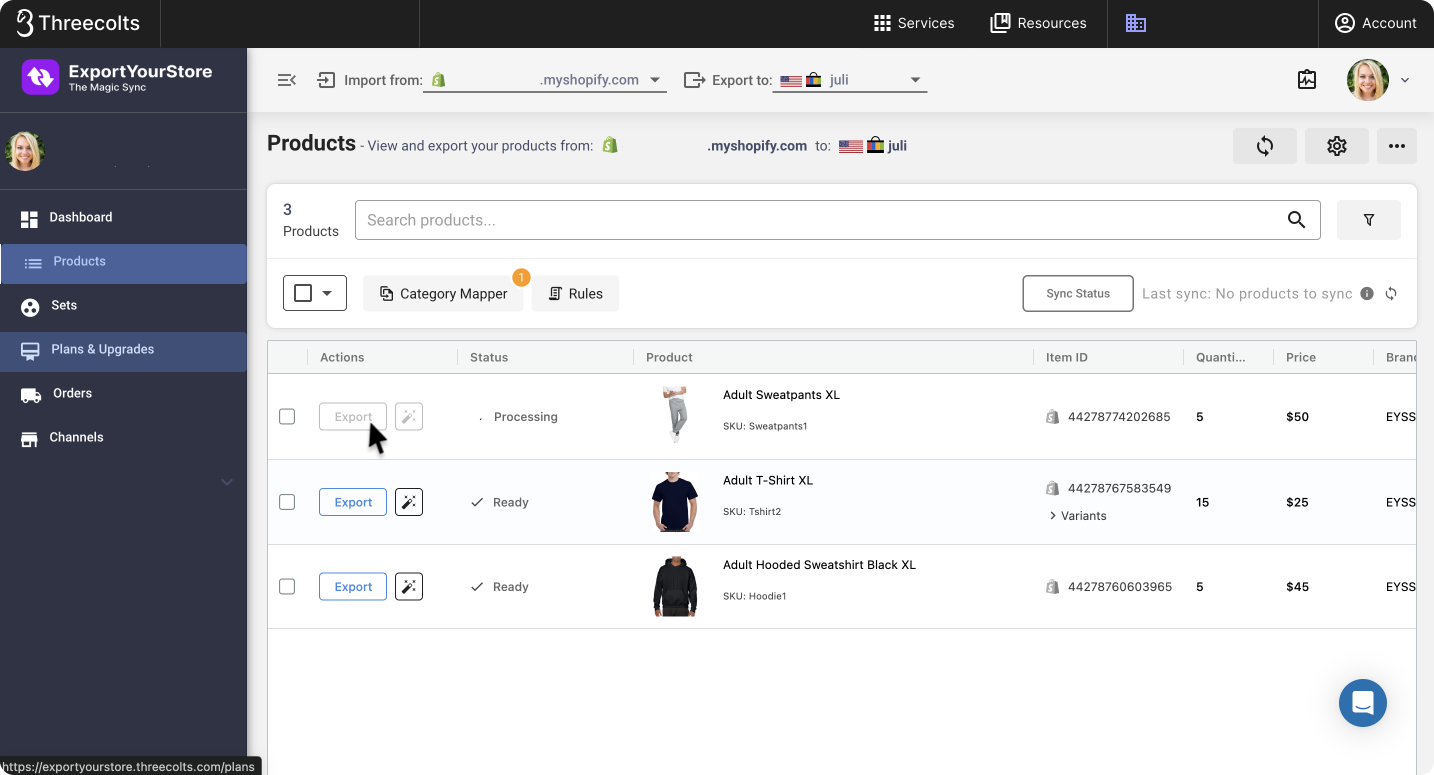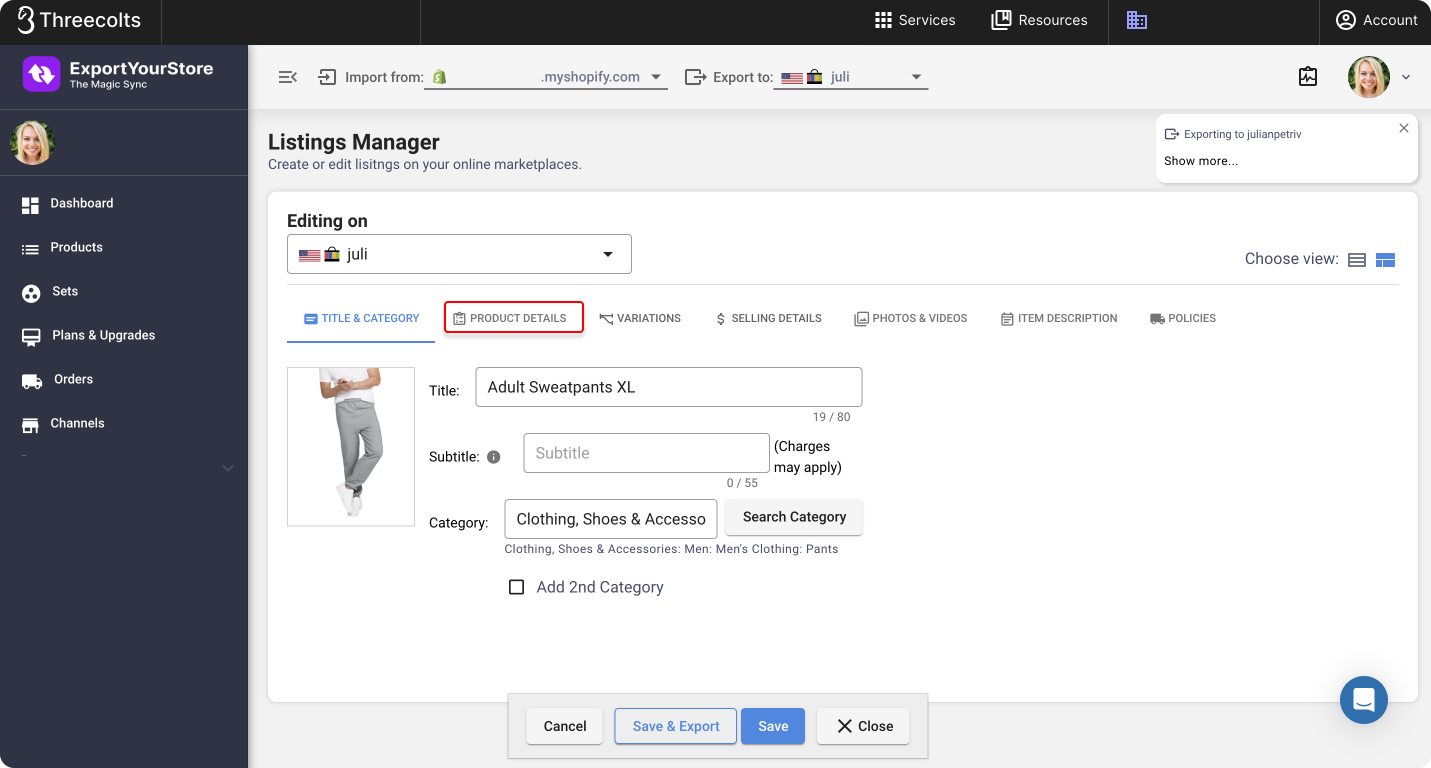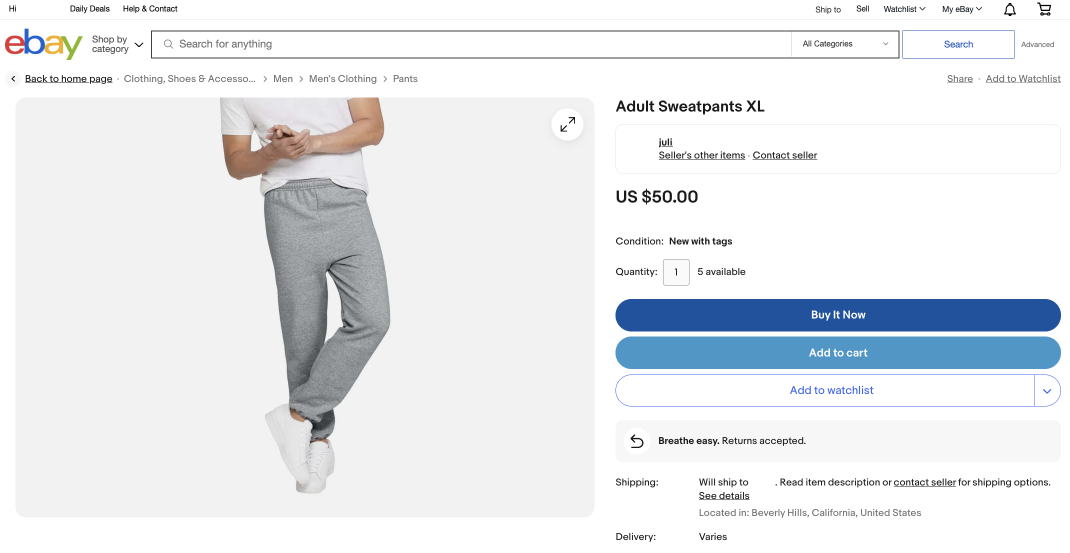One of the best ways to diversify your ecommerce business while simultaneously expanding your reach is through multichannel selling. Multichannel selling offers you a way to get the best of all ecommerce worlds – the stability of marketplaces, the independence of shopping cart stores, and the unparalleled virality of social commerce – while enabling you to minimize the risks associated with selling on a single platform.
For many sellers who currently sell on Shopify, selling on eBay is a smart and safe way to expand their ecommerce business into the realm of online marketplaces. eBay is a relatively seller-friendly marketplace, with a variety of seller tools and protections designed to help you get the most out of your eBay Store, all of which make it a very popular integration among Shopify sellers. Ready for a simple Shopify-eBay integration to kick off your multichannel selling journey? Keep reading to discover the benefits of using a Shopify-eBay integration app to sell on both channels, and learn how you can integrate your Shopify store with eBay in just a few simple steps!
.png)
What Does a Shopify-eBay Integration App Do?
Put simply, a Shopify-eBay integration app enables you to sell your Shopify products on eBay, all while managing them from your Shopify source store. But what does integration really mean, and what are the benefits of integrating Shopify and eBay? Are the differences between the platforms significant enough to warrant selling on both of them? Below, we'll dive into the ins and outs of what it means to integrate Shopify and eBay, and explain the differences between the two to help you understand the potential benefits of integrating your Shopify store with eBay.
What is a Shopify eBay Integration?
The term Shopify-eBay integration describes a multichannel selling structure in which a Shopify sales channel (i.e. a Shopify webstore) and one or more eBay sales channels (i.e. eBay Stores/selling accounts) list and sell the same items, using the same stock. This means that the same item will be listed on both eBay and Shopify simultaneously until it is sold on either eBay or Shopify. Integration involves synchronization between the two sales channels in terms of orders, inventory, pricing, and product data.
Benefits of Integrating Shopify and eBay
Integrating your Shopify and eBay sales channels gives you a more streamlined way to sell on both platforms. Rather than selling on each channel separately, integrating your Shopify and eBay sales channels with a Shopify-eBay integration app creates a more synchronized selling experience. The benefits of integrating Shopify and eBay include:
- Seamlessly synchronized inventory and orders, which helps you avoid overselling
- Selling on more channels gives you a wider reach that can potentially boost your sales
- A simplified, consolidated order management process for both sales channels directly through ExportYourStore
- Bulk management of product data and pricing, with automations and rules
- Easy product mapping
- A simple way to diversify your ecommerce business
Furthermore, when you integrate your Shopify store with eBay using ExportYourStore, you're just a click away from many more sales channel integrations that transform your Shopify store into the operations hub of your multichannel ecommerce business.
Differences between Shopify and eBay
eBay and Shopify are two very different sales channels, and each one has its own benefits and drawbacks. For starters, Shopify is a shopping cart platform, which means that your store is a standalone site. eBay, on the other hand, is an ecommerce marketplace, where sellers can open an eBay Store and list their products.
With Shopify, you get far more freedom to list and sell as you want, but this freedom comes with more risk when something goes wrong, and requires more investment in marketing and SEO to ensure that your store gets seen by potential buyers. eBay offers a more structured sales experience compared to Shopify, and comes with seller protections and tools that keep you safe and help you succeed on the marketplace. On the other hand, selling on eBay is also far more limiting than selling on Shopify – you'll have seller metrics to keep on top of, and will need to adhere to various listing and selling requirements in order to keep selling on the platform.
.png)
How to Set Up a Shopify eBay Integration
Setting up your Shopify-eBay integration with ExportYourStore is simple and secure, and enables you to integrate your sales channels exactly the way you want. Below, we'll show you how you can set up your Shopify-eBay inventory sync with ExportYourStore in just four simple steps, so you can start selling smarter on both eBay and Shopify today!
Step 1: Connect Your Shopify and eBay Accounts

You'll begin your integration by linking your Shopify and eBay accounts with ExportYourStore. This setup takes just a few minutes, and simply requires you to authorize ExportYourStore to link to each account. A simple setup wizard will guide you on how to connect your Shopify source store and your eBay target store. Once you've linked both sales channels, your Shopify products will begin importing into ExportYourStore, but will not be exported to eBay yet.
Step 2: Define Your Listing Sync Settings

After you've linked your Shopify source store and your eBay target store, you'll need to tell ExportYourStore a few things about how you want your stores to integrate. These Shopify-eBay sync settings enable you to determine whether or not prices sync between Shopify and eBay, whether or not newly created Shopify products cross-list to eBay automatically, whether inventory is automatically synced between Shopify and eBay, and more.
Below, we'll take a look at some of the sync settings to help you better understand each one, as well as the various ways you can customize your eBay listings, edit your products, and map product categories between Shopify and eBay.
Customize Your Title, Description, and Images

Now that your Shopify products have been imported to ExportYourStore, you can edit them to optimize them for eBay. You'll be able to edit the product title and details, define their product category, edit product variations, edit item images, and more.
Use Bulk Editing to Save Time

If you have many products, you may find it easier to edit certain product attributes in bulk. ExportYourStore enables you to edit titles, descriptions, keywords, product categories, images, and item specifics with bulk actions. You can find the items you want to edit with a search, narrow them down with filters, or edit everything in one go.
Set Up Automated Listing Rules

ExportYourStore also enables you to define custom rules for editing your products in bulk based on a variety of parameters. You could choose to create a rule that modifies the item title in a certain way based on its product category, add sale tags based on pricing modifications, and more.
Set Up Category Mapping Between Shopify and eBay
Finally, to finish setting up your integration settings, you'll need to define your category mapping. This simply means matching the Shopify product category to the best corresponding eBay product category for your products. Without a defined product category mapping, you won't be able to export your Shopify products to eBay.

Here, we can see that we have four items with Shopify categories that have not yet been mapped to their corresponding eBay categories. To define the mapping for this product (and for all other products in this Shopify category, now and in the future), we'll click "Map."

Now, we can search eBay's product categories to find the best match for our product, a pair of sweatpants. We'll select the eBay category "Clothing, Shoes, & Accessories: Men: Men's Clothing: Pants" to correspond with our Shopify product category "Sweatpants." In the future, whenever another product on Shopify is categorized in the "Sweatpants" product category, it will automatically be categorized in the "Clothing, Shoes, & Accessories: Men: Men's Clothing: Pants" category when cross-listed to eBay.
Step 3: Create eBay Listings from Your Shopify Products

Now, your Shopify products are ready to export to eBay. Select which products you want to export manually, with filters, or by search, or simply export all of them at once by selecting all and clicking on "Export."
How to Fix eBay Listing Errors

At times, you may encounter errors with certain products that could not be exported to eBay. To resolve these errors, simply hover over the question mark next to the error message to see more information. As we can see in the error message, this product cannot be synced because it is missing the product attributes "Size Type, "Color," "Style," and "Inseam."

To fix this error, we'll start by clicking on "edit" so we can make changes to the product and add the missing information.

Since the missing information is product details, we'll click on the "Product Details" tab in order to add the missing product attributes.

Now that we've added the missing attributes, we can click on "Save" to save the changes, or "Save & Export" to save the changes and immediately export the product to eBay. We'll click on "Save & Export," so our product will export to eBay right away.

Now we can see that the status of the item has changed from the error status of "Missing Specifics" to "Listed & Syncing." This means that the product has successfully exported to eBay, and is syncing with our Shopify sales channel.

This is what our product looks like on eBay. It's live and listed, with all the necessary product attributes included in the listing.
Step 4: Manage Orders and Inventory Across Shopify and eBay
.png)
Once your stores are integrated with ExportYourStore, you'll be able to integrate your order management workflows, too. View orders from both Shopify and eBay in the orders section, and take order actions like adding tracking information, updating order status, and generating CSV order reports. This consolidated order view makes it easier to manage your multichannel orders by enabling you to streamline your order management workflows on both sales channels.
Tips for Successful Shopify eBay Integration
A good Shopify-eBay integration app is just one part of a successful multichannel Shopify-eBay ecommerce business. Expanding from Shopify to eBay requires adapting to the new platform in many ways – there are marketplace listing rules you'll have to adhere to, customer service standards, and competing sellers, all of which will affect the way you list and sell on eBay. In this section, we’ll take a look at a few tips for ensuring that your Shopify products get the best possible start on eBay.
Optimize Your eBay Listings for Better Visibility
In our experience, the most important thing Shopify sellers can do when exporting their products to a marketplace -- be it eBay or any other ecommerce marketplace – is optimizing their listings for SEO. Every marketplace has its own search engine – on eBay, the search algorithm is called Cassini – which determines which listings are matched with which buyer search queries. The more optimized your eBay listings are, the better their chances of being seen by interested buyers. While on Shopify your site and products are optimized for external search engines like Google, on eBay, you'll want to prioritize product optimization for eBay's search engine, Cassini.
But how do you optimize your Shopify products for selling on eBay? First, you'll need to learn how to optimize listings on eBay. eBay's algorithm takes many factors into account when determining which listings to match to which search queries, and how to rank them in the results page. As a starting point, we recommend checking out eBay's guide to listing optimization to help you understand what you'll need to optimize. In terms of the how, you'll be able to create automated integration rules to optimize every aspect of your Shopify products for listing on eBay. You can create rules to modify titles and optimize them for eBay's search engine, for example, or make changes to product images to comply with eBay's listing image requirements.
Utilize eBay's Promotional Tools
eBay is a marketplace with an impressive selection of promotional tools and advertising programs for sellers. Sellers who have an eBay Store have access to Seller Hub Promotions, an indispensable toolbox of promotional features that include sales, coupons, and discounts. Additionally, eBay has a selection of advertising programs accessible to sellers via eBay Ads, which offer a selection of listing promotions based on the type of listing you wish to promote. eBay Ads offers a uniquely accessible advertising solution, with automated campaigns and daily ad spend suggestions, making it an ideal way to both promote your products and get a bit of experience in the world of online advertising.
Price Your Products Competitively
While this is true for standalone webstores as well, the fact that eBay brings together many thousands of sellers selling similar products makes a competitive pricing strategy an absolute must for successfully selling on the platform. When creating your pricing strategy, it's important to conduct thorough market research into both currently listed and sold items, which will help you understand not just what sellers think their items are worth, but what buyers are actually willing to pay for them. Once you've determined how you want to price your items, you can use ExportYourStore to automatically adjust prices for products cross-listed from Shopify to eBay.
Provide Excellent Customer Service
On Shopify, you run your own store and follow your own rules. On eBay, things are a little different – there are customer service metrics and feedback, and your success on the platform hinges quite heavily on the quality of your customer service. This means fast shipping times, timely responses to pre- and post-sale inquiries, and a return policy that qualifies you for the highest level of seller protections. Quality customer service can go a long way towards establishing your eBay Store, boosting your credibility with buyers, and even improving your listings' search rankings.
.png)
Final Thoughts & Key Takeaways: Why ExportYourStore is the Best Option for Shopify eBay Integration
Integrating your Shopify store with eBay is a great way to expand your reach, increase your sales, and begin selling on multiple channels. Multichannel selling is an effective way to grow your business, but it requires a good multichannel integration app to integrate and sync sales channels.
ExportYourStore offers a complete Shopify-eBay integration solution, with automations and rules that enable you to cross-list from Shopify to eBay in the most effective way possible. Furthermore, ExportYourStore is unique in that it allows you to continue managing your integrated multichannel business in a way that you're already familiar with: through Shopify. This means you can take your time getting to know the eBay interface, and enables you to keep your daily selling workflows intact.
Ultimately, the best way to integrate Shopify with eBay is with an app that you know you can rely on to effectively cross-list your products, sync your inventory, and consolidate your orders into a simple interface. With ExportYourStore, you get all that, and so much more, giving you everything you need to successfully list and sell on eBay, and on many more of the internet's leading sales channels.
FAQs for Shopify-eBay Integration
Still wondering whether you should set up a Shopify-eBay integration? Curious about the differences between Shopify and eBay? Check out these frequently asked questions from Shopify sellers looking to integrate their Shopify store and start selling on the eBay marketplace.
Q: What is the difference between Shopify and eBay?
Shopify and eBay are two distinct kinds of ecommerce platforms – Shopify is a shopping cart platform, which enables sellers to create a standalone webstore hosted on their own website, while eBay is an ecommerce marketplace, which allows sellers to list and sell by creating an eBay account and listing their items on eBay itself.
This fundamental difference makes for a wildly different listing and selling experience, and requires two different approaches to marketing, listing, customer service, product management, and more. Many Shopify sellers choose to integrate their store with eBay and sell on both platforms simultaneously, which allows them to reap the benefits of both sales channels while significantly expanding their reach.
Q: How do I connect my Shopify and eBay accounts?
The best way to connect your Shopify and eBay stores is by using a third-party Shopify-eBay integration tool like ExportYourStore. Integration apps offer a simple solution for multichannel selling, and enable sellers to sell on several sales channels, with the same inventory, at the same time. Shopify-eBay integration includes inventory synchronization between channels, automatable optimization for cross-listed products, a consolidated order management interface, and pricing synchronization, to name a few, which enable smooth and seamless selling on Shopify and on eBay.
Q: Can I import my existing Shopify products to eBay?
You can easily import your Shopify products to eBay with ExportYourStore, a simple multichannel ecommerce integration app that enables seamless selling on multiple platforms. To import your Shopify products, simply link your Shopify and eBay accounts to ExportYourStore, define your integration settings, and export your products to eBay. You'll be able to get your new eBay Store up and running in just a few hours, with perfectly optimized eBay listings thanks to automatable cross-listing rules.
Q: How often should I sync my eBay and Shopify stores?
Your Shopify and eBay stores should always be in sync, meaning that you'll need to consistently and immediately update each one to reflect changes made to the other. For example, if an item sells on Shopify and is no longer in stock, you'll need to make sure to end the listing for that product on eBay so you don't oversell. For most sellers, doing this manually is far from practical, which is why the majority opt for a Shopify-eBay integration app like ExportYourStore. When you use ExportYourStore to integrate your Shopify and eBay stores, both sales channels are continuously monitored and automatically synced in real time to ensure perfect integration between both selling channels.
.png)
%20(1).png)
%20(1).png)


%20(1).png)
